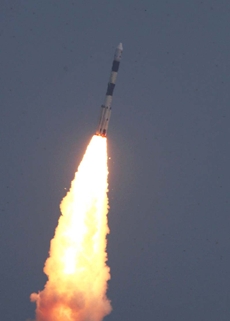Isro successfully tests Scramjet technology
29 Aug 2016
The Indian Space Research Organisation (Isro) on Sunday took the first step towards designing and developing advanced system that uses atmospheric oxygen to fire hydrogen powered rocket engines with the successful test-firing of the air-breathing Scramjet rocket engine that could cut the cost of space launches several fold.
 India now joins the select club that has developed or is developing Supersonic Combustion RAM Jet or Scramjet engines. So far only the US, Russia and the European Space Agency have demonstrated the advanced air breathing technology.
India now joins the select club that has developed or is developing Supersonic Combustion RAM Jet or Scramjet engines. So far only the US, Russia and the European Space Agency have demonstrated the advanced air breathing technology.
After a smooth countdown of 12 hours, the solid rocket booster Advanced Technology Vehicle (ATV) carrying the Scramjet engines lifted off at 6 am and ending a 300 seconds-flight, touched down in the Bay of Bengal, about 320 km from Sriharikota, the Banglaore-headquartered Isro said.
Isro successfully used the flight to validate critical technologies such as ignition of air breathing engines at supersonic speed, holding the flame at supersonic speed, air intake mechanism and fuel injection systems.
''The Scramjet engine designed by Isro uses hydrogen as fuel and the oxygen from the atmospheric air as the oxidiser. Today's test was the maiden short duration experimental test of Isro's Scramjet engine with a hypersonic flight at Mach 6,'' Isro stated in a release.
Isro said it used an Advanced Technology Vehicle (ATV) – a two-stage advanced sounding rocket – as the solid rocket booster to test the scramjet engines at supersonic conditions.
ATV carrying Scramjet engines weighed 3,277 kg at lift-off.
ATV is a two-stage spin stabilised launcher with identical solid motors (based on Rohini RH560 sounding rocket) at the first as well as the second stage (booster and sustainer).
The twin scramjet engines were mounted on the back of the second stage. Once the second stage reached the desired conditions for engine ''start-up'', necessary actions were initiated to ignite the scramjet engines and they functioned for about 5 seconds. Isro said, Sunday's ATV flight operations were based on a pre-programmed sequence.
The test helped Isro to overcome the technological challenges of designing and developing hypersonic engine air intake system, designing the supersonic combustor, development of materials withstanding very high temperatures and computational tools to simulate hypersonic flow, ensuring performance and operability of the engine across a wide range of flight speeds, proper thermal management and ground testing of the engines.
The successful technology demonstration of air-breathing scramjet engines in flight by Isro is a modest yet important milestone in its endeavour to design and develop advanced air breathing engines including engines for ISRO's future space transportation system, it added.













.jpg)






.jpg)









